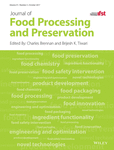Minimization of Antinutrients in Idli by Using Response Surface Process Optimization
Abstract
Deploying response surface methodology, the stages of idli preparation were optimized for minimizing the level of antinutrients. Under optimum conditions of soaking blackgram dal (1:5 of dal and water at 16C, and pH 4.0 for 18 h) and rice (1:5 of rice and water at 16C, and pH 5.6 for 18 h), the tannins content, trypsin inhibitor activity and hemagglutinating activity reduced, while phytic acid content remained unchanged. The optimum conditions for fermentation of dal-rice (1:2) mixed batter were 16 g/kg common salt supplementation and 19 h at 35C, resulting in a decrease in all the antinutrient levels, except amines. Steaming for an optimized period of 20 min further reduced the phytic acid content and trypsin inhibitor activity. In idli, while total biogenic amines content increased by 339% over raw ingredients, tannins content, phytic acid content, trypsin inhibitor activity and hemagglutinating activity decreased by 100, 89, 58 and 100%, respectively.
Practical Applications
For idli preparation, the optimization of processing stages using response surface methodology significantly minimized the level of antinutrients from both blackgram dal and rice without affecting the organoleptic attributes of the product. The optimized process parameters can be applied to household level and are also useful in scaling up idli production with a minimum level of antinutrients and better consumer acceptability. The outcome of this research can be exploited to other legume-based foods as well, particularly in developing regions where the consequences of antinutrients may exacerbate malnutrition and disease, thus effectively utilizing full potential of the legumes as human and animal foods.




